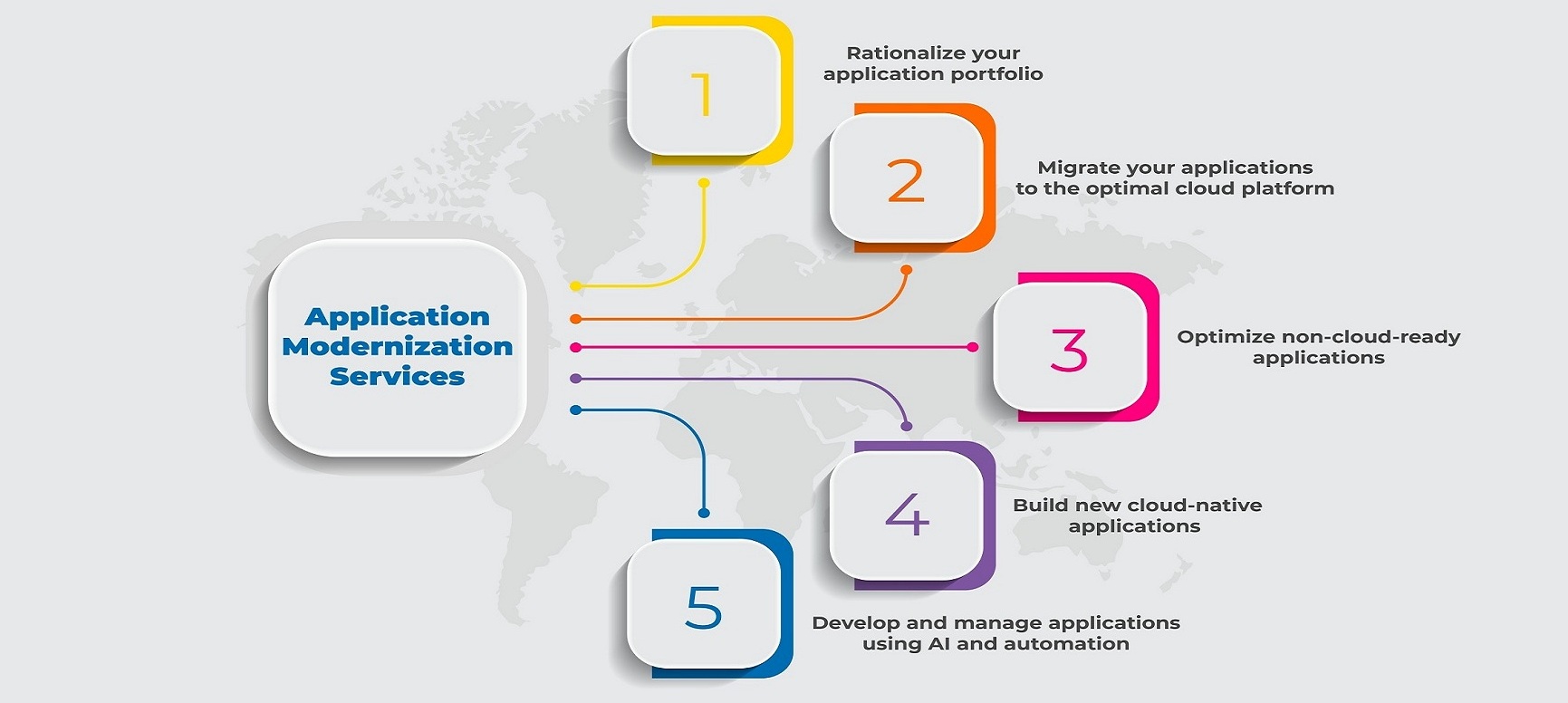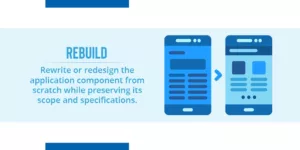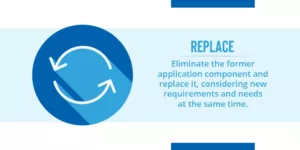Application modernization is the repurposing, consolidation, or refactoring of legacy programming or software code. It helps to create new or value from existing applications to align them more closely with business needs. In addition, application modernization services update legacy applications to scalable, resilient environments to meet user expectations as they evolve. You can do this using modern technology stacks, including the cloud. Application modernization services can aid businesses in the cloud.
Application modernization is sometimes also called legacy modernization or legacy application modernization.
What is Application Modernization?
The practice of updating older software for newer computing approaches, including newer languages, frameworks, and infrastructure platforms is called application modernization or legacy modernization. By extending an organization’s applications’ lifespan and taking advantage of technological advancements, application modernization extends an organization’s application’s lifespan instead of retiring it or replacing it completely.
Applications modernization can be a boon to organizations. They will achieve the greatest results when they move their delivery practices, services, and cultures to the cloud. This video from AWS Events sheds light on how you can take full advantage of the cloud by modernizing your people, processes, and applications.
Source: AWS Events(YouTube)
Why Application Modernization?
Embracing cloud and agile development processes is the most direct path to innovating software delivery by leveraging the cloud— an approach that meets the pace of demand today. This agility makes an organization more adaptable to future market and technology disruptions and better handle unforeseen competition, customers, and technology changes. The ability to excel amidst change is key to long-term viability.
The application Modernization services help improve development agility and reduce IT backlog to focus on delivering new business value and reducing technical debt instead of just keeping the lights on. Ideally, enterprise IT must operate as a business partner capable of delivering functionality in line with business and customer demands to achieve maximum ROI.
Legacy applications modernization ensures satisfied customers and happier employees by meeting UX and performance standards and secures your IT infrastructure from external threats and internal security breaches. It also addresses the financial inadequacies of the legacy system.
Why do Organizations Need Application Modernization Services?
Every day the rising need for agility in businesses, evolving customer expectations, and reliable & optimal use of Big Data and cloud-native technologies have resulted in the rise of application modernization services driving Digital Transformation across enterprises. Today, digital transformation is a must to keep your business competitive in a rapidly changing technological landscape. Owing to this, business applications have a hard time surviving due to various downsides. So modernizing applications at the right time will give your business a strong edge over your competitors.
Application Modernization Services
Application modernization services involve migrating legacy applications or platforms to new ones as well as integrating new functionality to provide the latest features for the company. Platforms can be re-platformed, re-hosted, recoded, rearranged, re-engineered, interoperable, replaced, and retired, as well as changes to the architecture of applications to formulate which option should be selected.


- Rationalize your application portfolio – identify which applications should you upgrade, retire, or move to the cloud.
- Migrate your applications to the optimal cloud platform – After evaluating your portfolio, migrate your cloud-ready apps
- Optimize non-cloud-ready applications – Apps that are not cloud-ready can still be accessed and used in the cloud.
- Build new cloud-native applications – Develop cloud-native apps that are scalable, agile, and more resource-efficient.
- Develop and manage applications using AI and automation – Using Artificial Intelligence (AI) and automation to make your apps more reliable – whether they’re in the cloud or not.
Application Modernizations Services Patterns
Once you decide to modernize your applications, there are five key migration options. The five Rs of application modernization include Rehost, Refactor, Re Architect, Rebuild, and Replace. We have discussed some patterns of application modernization below here.
Re-architect to Stateless And Microservices
Traditional application architectures include complex monolithic programs, which increases the maintenance effort and impedes innovation. Furthermore, these applications are challenging to scale. One application modernization pattern is to understand business logic by leveraging domain-driven design techniques and automatic tooling – for example, identifying the business domains and application contexts that will go into each microservice by visualizing the logic in UML. One can start by extracting big parts of the application and continuing with an iterative process of decomposing it into smaller parts and wrapping it into remote stateless interfaces – REST APIs.
Re-platform and re-host to the cloud
As a first step to modernizing core business and mission-critical applications, move applications off legacy, aging, or non-strategic platforms. Examples: moving UNIX workloads and mainframe to Linux or Windows or entirely moving off a proprietary PaaS environment to avoid vendor lock-in. This may require technical modifications of the custom-coded applications, such as system call and API changes, to work on the target environment. But there are no changes to the business logic or application language. Packaged applications can be re-platformed to the same or an alternative package. The target hybrid cloud will provide greater flexibility to scale on demand. This approach offers the quickest ROI, fastest migration, shortest code freeze, and lowest risk option.
Re-architect with cloud-native architectures
Another step in the journey: continue refactoring applications to adopt a pure cloud-native architecture. These architectural patterns allow the design of modular applications where components are deployed automatically on each environment, loosely coupled, or where there is a greater insight into the health of the service. In addition, there are design patterns that make applications elastic. Patterns that allow the discarding and replacement of component instances to enable the system to heal.






Application Modernization Strategy
A key strategy is developing a long-term application modernization roadmap to effectively manage a business’s resources through legacy modernization. For most organizations, it is better to approach application modernization in a piece-by-piece manner rather than all at once. This can help teams properly manage their existing applications’ performance while undertaking the work of modernization.
Another foundational strategy for successful legacy app modernization is to conduct a thorough analysis of candidate applications. This assessment should include evaluating the app’s suitability for cloud migration or similar shift, technical characteristics, the application’s interdependencies with other systems, the ROI of undertaking such a modernization, and other criteria.
Key technologies for application modernization
We highlight the five key application modernization technologies below.
Microservices
This describes a software development approach in which applications are structured as loosely coupled services. Instead of using a single, complete codebase—usually called a monolith or monolithic development to build and operate an application, organizations can deploy & run applications separately from the rest of the IT ecosystem.
Data Lakes
Data Lakes are digital repositories capable of storing structured, semi-structured, and unstructured data gathered from real source streams or on-premises sources.
Containers
Containers are a cloud-centric method for deploying, packaging, and operating applications and workloads. The benefit is that containers are well-suited for cloud infrastructure, and especially multi-cloud and hybrid cloud environments.
Purpose Built Databases
Purpose build databases are designed for specific data models. They are handy for supporting scalability in business applications that meet certain business standards.
Serverless
It is a cloud computing approach. Serverless cloud computing includes public cloud platforms, private clouds, and hybrid clouds. Hybrid usually refers to public and/or private clouds integrated with on-premises environments.
Orchestration and Automation
Orchestration in software development refers to the automation of many of the operational tasks associated with containers, including networking, deployment, and scaling. It is increasingly necessary to ensure that development, operations, and security teams can sustainably manage their modern apps at scale; hence one must take automation seriously.
Some of the compelling reasons enterprises need application modernization services are:
- Older applications can get outdated very fast and are not built for the cloud or serverless functioning. Therefore, maintaining older applications in the cloud can be more work than it’s worth. Older applications also limit your employee pool.
- Modernization provides greater security and greater functionality.
- Engagement grows when you give your users a better UX and a platform that increases productivity, creativity, and innovation.
- Modernization with the cloud offers you scalability and stability. In addition, applications operating in a cloud provide greater mobility, accessibility, and maintainability.
- Application modernization services helps enterprises develop an agile framework that reduces the time and cost of resources. As a result, developers can spend more time building productive applications and enhancing the organization’s potential to grow faster.
- With the increasing acceptability of remote working, and agility where applications are no longer OS-dependent, thanks to containerization, developers can free their arms and code with multiple OS instances. At the same time, microservices make functional fixtures easier to update, where each function or microservice within the application can be allocated to teams with respective owners. As a result, this leads to room for experimentation, innovation, and healthy competition, accelerated growth.
- Real-time accessibility of modern apps, easy data entry through mobile devices, increased security through geo-fencing in mobile apps, and encryption has improved customer service, fewer risks, fewer audits, and simple compliance.
- Generating new business value from existing applications using application modernization. If existing applications are not only being supported but enhanced as well, they can perform better and will, respectively, serve better business value that matches the needs of clients.
- Optimized application adaptability, which has automated, platform-independent, and state-of-the-art solutions, is yet another advantage that derives undeviatingly from modernized applications and, more concretely, optimized application adaptability.
Application modernization trends


Four major themes of legacy applications in 2021 are:
- Onboarding is more critical than ever with the increase in remote working
- Legacy applications are hindering the growth of enterprises
- The demand for new technologies is growing
- Poor integration is costly in case of system failures
These factors make for a compelling sense of urgency to solve integration challenges once and for all. Companies must recognize the shortcomings of existing integration offerings. Still, they also should find better solutions and take action to drive the market demand for more sophisticated integration platforms in the process.
If you have challenges in your organizational processes or applications and would like us to review, plan, and modernize them, get in touch with us today!




I like the idea of repurposing, consolidating and refactoring legacy programming or software code. I’m sure that this will help improve development agility and reduce IT backlogs. The five Rs of application modernization are a great way to manage resources through legacy modernization!
Very informative!!
I thoroughly enjoyed your article, I wanted to write a little comment to support you and wish you a good continuation All the best for all your blogging efforts.
Keep working, great job!